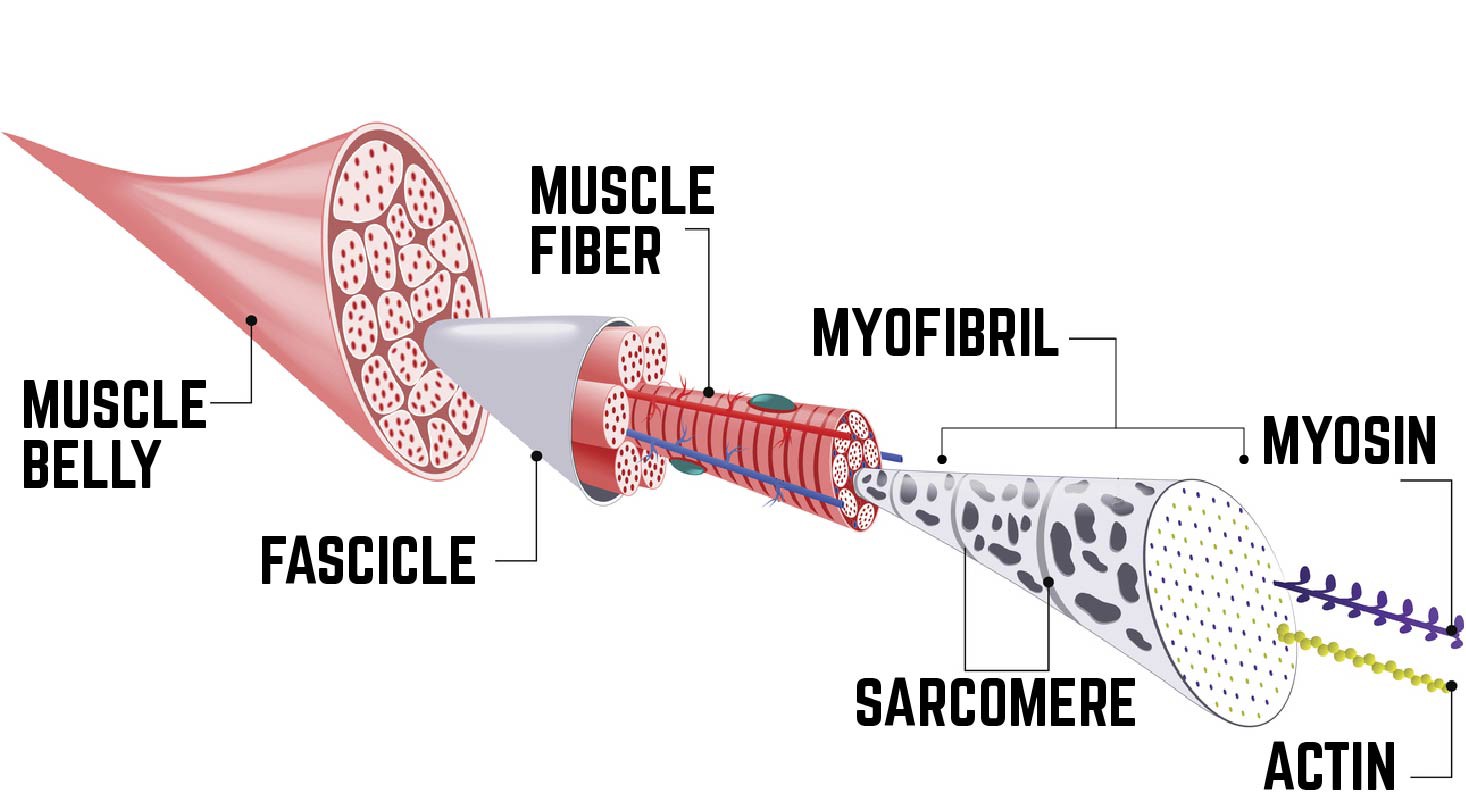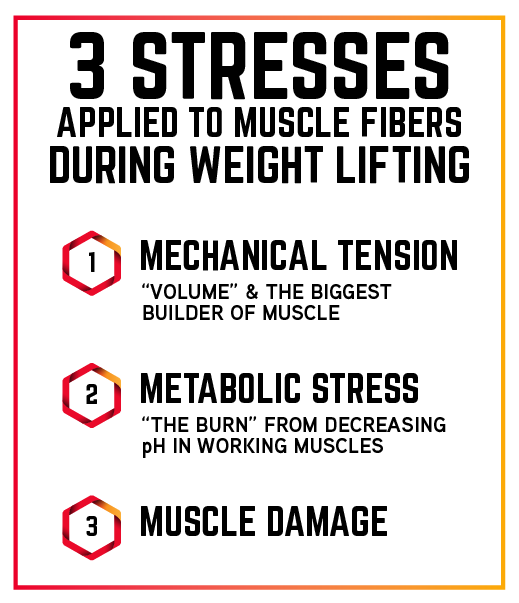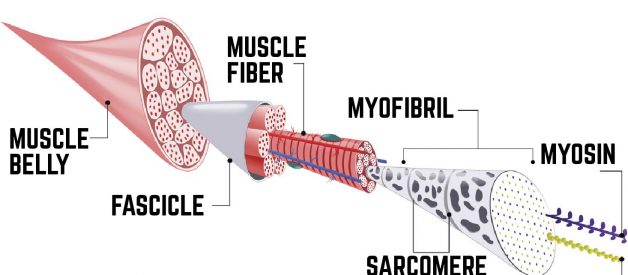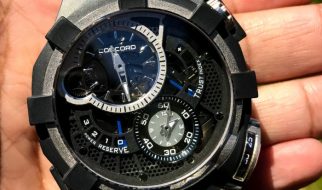Maybe you?ve spent a week in the gym, or maybe this is your tenth year pumping iron. Either way, what?s happening just below your skin ? like the glory of a great pump or the devastating soreness after leg day ? is probably still a mystery to you.
And that?s a shame because, while so many focus on the fine details of how to make their muscles grow, the basics get lost in the confusion. What does it mean to be anabolic? What do terms like ?muscle protein synthesis? and ?hypertrophy? mean? What really makes muscles grow, and why does building muscle matter?
We need to clear this up. Because muscle isn?t just the show-boat organ of the body ? it?s important for our health, longevity, and metabolism. Even if your goals aren?t meaty thighs and boulder shoulders, you could benefit from adding lean body mass. Understanding the basics of muscle growth will help you sort fact from bro-science, and smart decisions from wastes of time.
The Mechanics of Muscle Growth
When you flex your bicep (and the science isn?t clear about whether this has to be in front of a mirror or not) you?re contracting thousands of small muscle fibers. Each of those fibers is a muscle cell, made of thousands more ?links? called sarcomeres. When our brain sends a signal to move, the chain reaction that flexes your guns starts here. And inside each sarcomere (I swear this is the last stop on the Muscle School Bus) are even tinier ?contractile fibers? called actin and myosin [1]. This is where the magic of muscle growth happens.

Muscle growth (or ?skeletal muscle hypertrophy,? as it?s called at science parties) is the result of a complex process that adds more myosin ?filaments? to each muscle fiber. This makes the ?engine? of the cell bigger and stronger over time.
But building a bigger engine isn?t easy, and your muscle can?t do it alone. It needs two things: parts (protein) and a mechanic (mTOR).
mTOR stands for the ?mammalian target of rapamycin? ? and now you can see why we use the short version. It?s a complex protein that regulates when and how much your body starts to build muscle. When you hit the weights, you wake up mTOR (the mechanic) so he can go to work. This process is called muscle protein synthesis, or MPS.
If that was all there was to it, life would be very simple. All we?d have to do is lift some weights, let mTOR do his thing, and we?d explode with muscle. Unfortunately, MPS has an evil twin, muscle protein breakdown, that directly counteracts it.
When these two forces are balanced, you don?t gain or lose muscle. If your ?protein balance? is positive, the surplus can be directed (by resistance training) into muscle cells. But, if you?re in a negative or neutral protein balance, there?s no fuel for the engine and no parts to make it bigger. So, to put on muscle you?ll need to force your body into a net positive protein balance. Then MPS gets the upper hand.
In bro-science, you?ll hear this lovingly called ?being anabolic? ? basically, the state of building tissues in the body ? as opposed to the evil ?catabolic,? which breaks everything down and makes you lose your gains.
But there?s a little more to it than that.
Your body is never purely anabolic or catabolic, and no matter what you do, you?ll always have some muscle synthesis and breakdown happening all the time [4]. Even the things we think are ?good? for muscle growth, like resistance training, can be both anabolic and catabolic [3]. What matters is that the average of those comes out positive (muscle gain) instead of neutral or negative. And just like counting macros, it?s what you do on a daily, weekly, and monthly basis that determines your success in the long run.
(How long is the ?long run?? Check out our article ?How Fast Can You (Naturally) Gain Muscle??)
Tipping the Scales: Positive Protein Balance
So, how do you tip the scales of synthesis and breakdown in your favor?
If you?ve scoured magazines looking for every dark secret of muscle growth, you might think this part is pretty complicated: pound a protein shake before and after your workout, take BCAAs while you lift, use short rest periods, train to failure, stick to high reps? The trouble is, most of the things people spend their time and energy on aren?t that important, or worse, don?t help them at all.
The science can go deep, but all you really need to know are the basics: train hard and get plenty of protein.

When you lift weights, you?re increasing muscle protein breakdown. But later, while you recover, the pendulum swings back the other way and mTOR goes to work [4]. Lifting weights applies three types of stress to muscle fibers that signal for them to grow: mechanical tension (which you may have heard called ?volume?), metabolic stress (think: ?the burn? which comes from decreasing the pH in working muscles), and muscle damage [6]. Old school bodybuilders might say muscle damage is the key to growth, but science doesn?t back this up [7]. What we do know is that volume (tension) is the biggest builder of muscle. Adding volume over time (in the form of weight, reps, or sets) will allow you to keep making gains.
To put things simply: lifting weights and training hard builds muscle. Obviously, the nuts and bolts of exercise are more complicated, so if you?re not sure what to do in the gym, check out our two-part series on ?Programming for Muscle Growth?.
And then there?s the other half of the equation: protein. mTOR needs parts to build the engine, and those parts are essential amino acids. Because your body can?t synthesize these on its own, you need to get them from your diet. Some proteins, like leucine, are especially important because they directly stimulate MPS [8]. But we don?t need to wander into those weeds. If you?re getting most of your protein from high-quality sources like meats, dairy, and eggs, then you?re probably getting plenty of the essentials you need to build muscle.
How much daily protein is enough? It?s different for everyone, but 1.4?2 grams of protein per kilogram of bodyweight per day is a good place to start [9]. If you?re 150 lbs, this means eating between 95 and 136 grams of protein. But, if you?re using Avatar, this part is taken care of for you. And because the Avatar system bases its protein recommendation off of your lean body mass (your bodyweight minus fat,) your macros are tailored more specifically to you. Hitting these targets will get you all the essential amino acids you need to build muscle. Then, resistance training tells your body what to do with them.
So, now you have the ?secrets? to maximizing mTOR: eat protein and lift [3].
But is this all that matters? Do other things affect how much muscle you can build, or how quickly? Let?s go through a quick play-by-play of the muscle FAQs:
- If you don?t drink a protein shake right after your workout, will you lose all your hard-earned gains? No! It?s not clear how much protein timing matters, but we know it?s not necessary. Total daily protein matters far more, so that?s one less thing you need to stress about [9].
- What about BCAAs? Same answer. BCAAs taste great, but they?re not magic. In fact, they?re just three of the essential amino acids that you?re getting anyway from high-quality, protein-dense foods like meat, dairy, and eggs! (And if you?re already spending money on whey protein supplements, you?re already getting BCAAs from that.) Let?s just say it?s not the wisest way to spend your money.
- What about carbs? If you want to get a little more dialed-in, you can pay attention to carbs. Getting some carbohydrate along with your protein (something like 4 grams of carbs for every 1 gram of protein) before or after training can boost the anabolic effect slightly [15]. This happens because insulin plays a role in regulating MPS [10]. However, I wouldn?t lose sleep over this, because it?s not a huge deal. Speaking of ?
- Does it matter how much you sleep? Okay, you?re not really asking that question, but I?m making you. Because the answer is Yes. Getting less sleep can increase the catabolic pathways that burn the bridge between you and muscle growth [14]. So, if you want the aesthetic of bigger muscles, get your beauty sleep!
Want to learn more about the most common muscle-building myths? Check out ?9 Common Myths About Gaining & Building Muscle?.
The Garden of Gains: Why Growing Muscle Matters
Now that we?ve climbed to the top of the mountain, we can put all this in perspective. Why does building muscle matter to everyone ? from college bros to grandmas?
Because muscle isn?t just about aesthetics ? it?s part of staying healthy! Increasing your lean body mass (LBM) can increase your quality of life now and especially while you age.
To understand why, you have to know the central role that protein plays in the body.
Your body has plenty of places to store fat and carbs, but no real way to ?store? protein ? except in muscle mass. During medical emergencies, your body needs extra protein to survive and heal, and it gets that protein from muscle tissue [11]. It might make your skin crawl to think about losing your hard-fought gains, but in the case of major injuries and critical illness, people with more LBM to use while healing have better outcomes.
Muscle is also an important part of whole-body metabolism. Some of the energy we expend each day comes from movement or eating and digesting food, but most of it comes from our body?s resting energy expenditure (REE). And while there?s not much we can do to change our REE, we can modify it the most by adding LBM [11]. While it?s a myth that muscle is highly metabolically active compared to other organs [12], muscle is the only organ you can increase to boost your metabolic rate [11]. You can?t add another lung or kidney, but you can put on plenty of muscle over time.
Finally, gaining muscle ? whether you?re young or old ? can fight two of the biggest problems with aging: muscle loss (sarcopenia) and bone loss (osteoporosis) [13, 11].
Am I saying that muscle is your armor against disease and the fountain of youth?
Maybe.
Quick Tips for Quicker Progress
The science of gaining muscle goes much deeper than anything we?ve touched on today, but the practice doesn?t have to be complicated. Here are some quick takeaways:
- Stay in a positive protein balance by hitting your protein consistently.
- Get your protein from high-quality sources like meat, eggs, dairy, and soy.
- Your body needs energy to grow, so it helps to be in a caloric surplus ? or at least in maintenance if you?re new to lifting.
- Make sleep a priority ? both quantity and quality.
- Hit the weights consistently, and train harder by adding volume (in weight, reps, and sets) over time.
You?re all set! Arm yourself with science, cloak yourself in muscle, and strike out into a stronger, healthier future.
REFERENCES[1] Marieb EN, Hoehn K. Human Anatomy & Physiology, 9th Edition (2012). Boston: Pearson. Print.[2] Goldberg AL, Etlinger JD, Goldspink DF, et al. Mechanism of work-induced hypertrophy of skeletal muscle. Med Sci Sports. 1975;7(3):185?98.[3] Deldicque L, Theisen D, Francaux M. Regulation of mTOR by amino acids and resistance exercise in skeletal muscle. Eur J Appl Physiol (2005) 94: 1?10.[4] McCarthy JJ, Esser KA. Anabolic and catabolic pathways regulating skeletal muscle mass. Curr Opin Nutr Metab Care (2010). 13(3): 230?235.[5] Kumar V, Atherton P, Smith K, et al. Human muscle protein synthesis and breakdown during and after exercise. J Appl Physiol (1985). 2009 Jun;106(6):2026?39.[6] Schoenfeld, BJ. The mechanisms of muscle hypertrophy and their application to resistance training. J Strength Cond Res. 2010; 24: 2857?2872[7] Damas F, Phillips SM, Libardi CA, et al. Resistance training-induced changes in integrated myofibrillar protein synthesis are related to hypertrophy only after attenuation of muscle damage. J Physiol (2016). 594(18): 5209?5222.[8] Dreyer HC, Drummond MJ, Pennings B. Leucine-enriched essential amino acid and carbohydrate ingestion following resistance exercise enhances mTOR signaling and protein synthesis in human muscle. Am J Physiol Endocrinol Metab (2008). 294(2): E392?400.[9] Jager R, Kerksick CM, Campbell BI, et al. International Society of Sports Nutrition Position Stand: protein and exercise. J Int Soc Sports Nutr (2017). DOI: 10.1186/s12970?017?0177?8.[10] Bolster DR, Jefferson LS, and Kimball SR. Regulation of protein synthesis associated with skeletal muscle hypertrophy by insulin-, amino acid- and exercise-induced signaling. Proceedings of the Nutritional Society (2004). 63(2): 351?356.[11] Wolfe RR. The underappreciated role of muscle in health and disease. Am J Clin Nutr (2006). 84: 475?482.[12] Wang Z, Zhiliang Y, Bosy-Westphal A, et al. Evaluation of specific metabolic rates of major organs and tissues: comparison between nonobese and obese women. Obesity (2012). 20(1): 95?100.[13] Evans WJ. What is sarcopenia? J Gerontol A Biol Sci Med Sci (1995). 50 Spec No: 5?8.[14] Dattilo M, Antunes HK, Medeiros A, et al. Sleep and muscle recovery: endocrinological and molecular basis for a new promising hypothesis. Med Hypotheses (2011). 77(2): 220?222.[15] Bird SP, Tarpenning KM, Marino FE. Independent and combined effects of liquid carbohydrate/essential amino acid ingestion on hormonal and muscular adaptations following resistance training in untrained men. Eur J Appl Physiol (2006). 97: 225?238.


